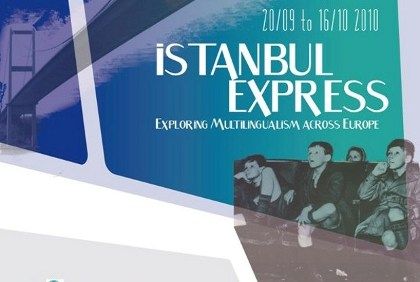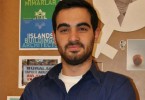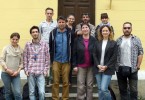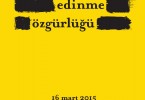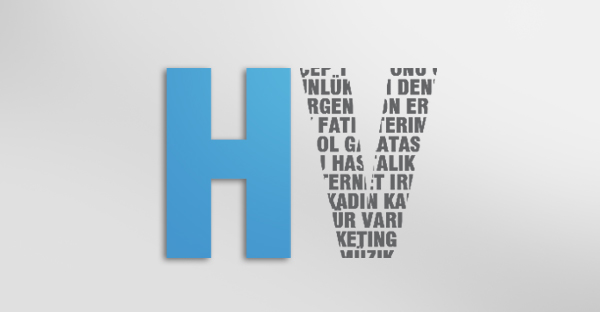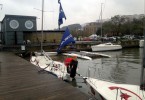Katti Djisuk Schroeter
Last week 45 young filmmakers from all over Europe came to Istanbul, their freshly shot documentary material with them, ready for editing and eventually screening. What made their project called “Istanbul Express” extraordinary was scores of languages spoken in their films shot in 18 different countries which they crossed on board trains.
The participants met in three European cities: Tallinn, San Sebastian and Turin. Divided into groups of three filmmakers (director, cinematographer and sound engineer), they made 15 short documentaries within three weeks on their trains to Istanbul and also during the last week in Istanbul. They stopped in a total of 24 cities, in 18 different countries for shooting.
Six days before showing their work the film teams arrived in Istanbul; less than one week left for editing the multilingual material they shot.
On Friday, October the 15th, they showed to an audience, equally multilingual and multicultural, the results of their three-week journey. In the French Institute they screened the 15 short documentaries. The young participants were from Portugal, Spain, the UK, Scotland, Belgium, France, the Netherlands, Switzerland, Germany, Finland, Sweden, Denmark, Romania, Poland, Hungary, Estonia, Croatia, Bulgaria and Turkey.
The documentary making was supervised by tutors, producers and coordinators who counseled the participants while shooting and editing.
Diverse film making approaches
Having the theme of multilingualism in common, the films, each about 15 minutes, had very different approaches: Some had a lot of talking heads in them, for example a documentary film about the inventor of the language ‘Slovio’ – an international language put together by elements of all Slavic languages as a counter reaction to the dominance of English. Some others were just observational, the camera only watching their protagonists without asking questions or intervening in an interviewing way. For example, a film about the clown Martha, living in Vienna and earning money as a street artist for herself and her son. Another one was more experimental, having long single shots of clouds, dogs and kids that seemed more like photographs than like films, but with sound collages in the background.
Controversy over clouds that were not even moving
The last one mentioned got the most controversial comments as some in the audience were searching for entertainment and information in the long shots of , for example, clouds that were not even moving.
The Serbian tutor and documentary filmmaker Boris Mitić told us how the team, including director Rui Silvera, cinematographer Bela Lukac and the sound engineer Marcin Knyziak happily found their way of editing: “We made this film very much like a visual art exhibition. The cinematographer would never wake up early in the morning to get the good light, he would never spend ten minutes setting up a nice shot, but he carries his camera with him all the time and he can recognize a good shot and the sound man showed me his website with still photographs only sound in the background and the sound is telling you a story. So I said, that’s it. We had only twelve shots, but very long ones, very static ones with a lot of strange different noise that really makes you think about a lot of things.”
However, some of the viewers did not enjoy the artistic way the film was made. We asked Zoe Townsend, an American exchange student for her opinion:
“The ones that I enjoyed the most were the ones when the topic was clear like the one about the language Slovio. It had some humor in it also and it left you with an idea of why this is relevant. I didn’t like the really abstract ones when it is just kind of vaguely random shots of who knows what and noises that didn’t really go with the shots, it didn’t seem like a documentary film to me because I didn’t learn anything but I don’t really know that much about films, I’m just an uneducated viewer“
Filming characters without understanding their language
“Martha,” shot in Vienna was a film by director Lyubomir Pechev, cinematographer Paulo Martinho, sound designer Ainara Vera Esparza.
Martha prepares well for her job: She exercises in the mornings on her horizontal bar, wraps herself in yellow linen, puts her make-up on, white face, tiny red cherry lips and leaves for work. At some public square in Vienna she watches her colleague showing his tricks to the street audience, applauds, pays some coins for him and starts her performance in front of the passersby. After earning money through playing the trumpet, trying to step on her wooden ladder which flips away as soon as she puts her foot on it, and wrapping herself in yellow linen again Martha, the clown, leaves her work place for home. Shortly afterwards her son is coming home, she asks for his homework, he puts his school bag in the corridor. Later on they spend their afternoon by having lunch, playing the European Anthem (Beethoven) on the piano and dressing like suitcases. It is Martha’s turn first: Only her legs are sticking out, the rest of her body is in the suitcase, her son sticks a red trumpet into the suitcase’s head, where no head is seen, but the trumpet is doing her job: A suitcase with human legs, moving like a giraffe is hooting. Later on the son is imitating his mom: Same brown leather suitcase, shorter legs, a baby giraffe discovering a living room in Vienna.
“How could the non-German filmmakers follow their German speaking characters in Vienna?” We asked Paulo Martinho, the Portuguese cinematographer of the film:
“What I was looking for were reactions, especially facial expressions, whether she would smile, whether she would argue, whether she would cry.”
Can the language barrier even be an enrichment instead only being a handicap for filmmakers making observational documentaries? “It is a difficult question,” Paulo replies, “Maybe yes, if you would be following me in this observational kind of look to the film and if I was just being myself in Portugal, speaking Portuguese with my friends, if I already know that you don’t speak Portuguese, than I would just be myself.” So this could be an advantage of the language barrier between filmmakers and film protagonists.
While making multilingual documentaries it is worth considering whether the lack of understanding the language could even be a good recipe for telling the story by visual images, like body language, rather than always searching for the words documentary protagonists are saying. Maybe it opens a door to between the lines instead of the lines themselves.
Antoine Cattin from Switzerland and one of the tutors told us his thoughts about this issue: “If your editor doesn’t speak the language, how can he edit it?” Some of the participants made local volunteers translate their material on the way, but eventually some of these hard-earned translated sentences would not even be in the final version. “It’s crazy, for me I cannot imagine”, Antoine says, but then he adds: “Okay, than you have another thing when you edit this type of cinema”, meaning documentary films, “what counts is the energy, what’s happening in the frame and it’s not just words, sometimes it’s absence of words.“ But Antoine remains undecided about this issue. Is it possible to edit a documentary by only searching for this energy without understanding the words?
Anyway, the somewhat avant-garde show was quite interesting since it illustrated the new concepts that young people are developing simultaneously in many European countries.

